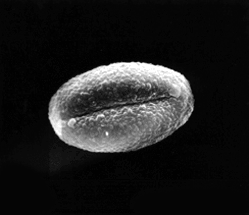Click on the name of a different pollen below to find out more about
it,
or click on the other microscope for a different view of this pollen.
| Plant: | Pollen: | Microscope: |
 |
 |
|
|
Bur Oak If you find yourself sneezing in spring, you may not have a bad cold, you may have an allergy to tree pollen. Trees that are pollinated by the wind, like the oaks, are the main cause of spring allergies. Scientists don't know which of the oaks are responsible, but they believe bur oaks may cause some springtime hay fever. Bur oaks don't begin to flower until they are about thirty years old. After that they flower heavily every two to three years for about a month in spring. Lots of flowers means a fall harvest of acorns for deer, squirrels, turkeys, rabbits, and other wildlife. You can usually tell a bur oak by its rough, scaly bark and thick gnarled branches. It is so tough it was once made into wagon axles, whiskey barrels, and ship decks. Bur oaks grow well on the central plains because their corky bark makes them resistant to natural prairie fires. Bur oaks live very long lives. They go on making flowers and acorns for centuries. Some of the oldest bur oaks alive today were young trees when the U.S. Declaration of Independence was signed in 1776. |